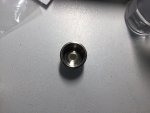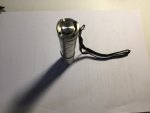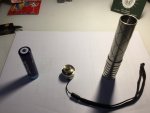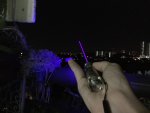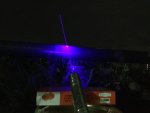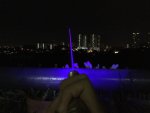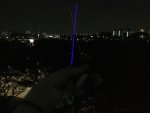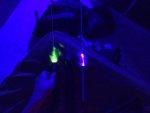- Joined
- Oct 7, 2015
- Messages
- 15
- Points
- 3
Introduction :
Hello LPF, I decided to get my first Sanwu laser, a Challenger II multi-mode 3W 450nm laser, and would be reviewing it in this post. As I am a new member, my review may not meet some of your criteria so I hope you will not be too critical. Anyway, let's jump into the review
Shipping :
I placed my order on 20/05/2019 for a multi-mode challenger II 3W 445nm with 18650 battery configuration, together with 2 protected 18650 3300mAh Panasonic battery. Within 8 days, I received an email from Francis notifying me that my order has been dispatched. It arrived to my country on 01/06/2019 and finally received it on 06/06/2019. The laser was packed in poly bubble padded envelope/parcel with 2 poly bubble padded bags inside, one for the laser head and the other for the laser body/tube and tailcap. The batteries came separate a few days earlier.
First impression of laser :
The most prominent properties of the laser its is mass. This laser is HEAVY! I own 2 other blue laser, a cheap WickedLasers style 1.3w and a DIY multi-mode laser, one of of which have a similar mass to the Sanwu laser despite being twice in length and volume. The treads are butter smooth and pre lubricated. The CNC engraved patterns are sharp and looks very unique. No burrs or scratches were seen on the laser, further emphasising on the high quality of Sanwu lasers.
Each separatable section of the laser includes a white o-ring, hence leading to me believing this is at least IPX4 water resistant(resist splashing water from all directions). One thing I noticed is that the driver is soft start. When turned on, the laser will start at <10mW output and then ramps up to full power in about a second, thus protecting the diode from voltage & current spikes. Furthermore, it also features a high temperature protection whereby the power output will be reduced if the temperature is too high. I noticed this when my beam brightness would slightly reduce suddenly after running the laser as full power(3W) for about a a minute and a half. This however did not help in the duty cycle conundrum which I will further discuss below.
Another thing that I noticed when I got the laser is that it includes a AR coated lens protector screwed in front of the G7 lens which keeps dust out and prevent the actual G7 lens from getting scratched. None of my other lasers include this feature so I am very impressed with Sanwu willingness to help their customers in terms of laser maintenance.
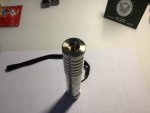

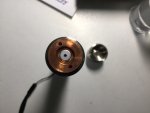
NDB7875 Diode(9mm)
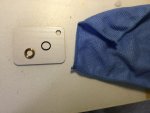
AR coated G7 lens protector with its own rubber o-ring
Specifications from Sanwu :
Laser body material : Nickel Copper Alloy(Cupronickel)
Size : 140mm X 24mm
Operation mode : Multi-mode
Laser Max Power : 3000mW
Divergence : 0.7mrad - 3.8mrad[Further calculation done below]
Voltage : 3.7V - 4.2V
Current : 0.5A - 2.2A[Further testing done below]
Power Supply : Single 69mm 18650 battery
Modes : Low Power, Half Power, Strobe, Full Power, SOS
Duty cycle : Unlimited except 4W 470nm(60s on & 80s off) --- [Further testing done below]
Laser Diode : NDB7875
NDB7875 diode manufacture specs :
Dominant Wavelength : 435nm - 450nm
Optical output : 1.6W @ 1.2A
Max Current : 1.7A
Operating Voltage : 3.7V - 5.5V
Package Size : 9mm
Build In Static Protection : Yes
Operating Temperature : 0 - 50 degree celcius
Qualitative Data Measurements :
Unfortunately, I do not have a LPM thus my assessment would not contain power readings:sad:
MASS :
Laser mass without battery : 217g
Laser mass with battery : 262.5g
CURRENT:
Sadly, I lost pictures for the tailcap current readings but I have prerecorded the measured tailcap currents on my iPhone notes.
Low power mode : 0.09A
Half power mode : 1.07A
Full power mode : 2.26A
*The current for strobe and SOS fluctuates so no readings are taken for these modes.
DUTY CYCLE :
Sanwu advertised this laser to have unlimited duty cycle. However, I soon found out that this was untrue. In full power mode, the laser reached 53.3 degree celcius in about 1 minute and 48 seconds and about 3 and a half minutes in 1/2 power mode. Hence, this laser HAVE a duty cycle as the NDB7875 diode reaches max operation temperature, 50 degree celcius, after a duration of time. Therefore, my personal duty cycle is 60 seconds on, 90 seconds off.(all temperature tastings are done in room temperature of 25.8 degree)
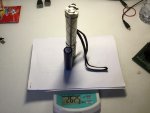

Measured divergence & Distance for safe laser Power Density :
As Sanwu's advertised divergence is a pretty large range, I decided to do my own test. Distance between the G7 lens optical centre to my wall is 9.065m. Diameter of beam at distance of 0m is 6mm and 17.5mm at 9.065m. Based on an online calculator, this gives a full-angle divergence of 1.27mrad.
Edit :
I was playing with the laser when I realised that the divergence calculated may be wrong since the dot area is larger than expected. Apprently, my intuition was correct.
Diameter when dist = 0m is 6mm
Test 1 :
Dist = 9.136m
Dia = 38mm
Divergence = 3.5mrad
Test 2 :
Dist = 6.001m
Dia = 20mm
Divergence = 2.33mrad
Test 3 :
Dist = 4.496m
Dia = 18mm
Divergence = 2.67mrad
Hence, divergence is from 2.67mrad - 3.5mrad. Way higher than my initial calculation and more in tune with Sanwu's listed specification.
Safety is my no. 1 concern in this hobby. Hence, I decided to do more calculations to find out what distance, in meter, would the laser power density be too Low to hurt the human eye when operated at the full 3W power :
Eye safe Power Density = 25W/m^2 = 25000mW/1000mm^2 = 0.025mW/mm^2 -- α
Assuming the relationship between the length and breath of a rectangular beam of a multi-mode diode increases linearly and proportionally with each other, Let Y be the breath and X be the length.
When Y = 9mm , X = 75mm -- 1
When Y = 13mm , X = 90mm -- 2
When Y = 25mm , X = 138mm -- 3
From 1, 2 & 3 :
Y = kX , where k is an arbitrary constant.
k = Y/X
1 : k = 9/75 = 0.12
2 : k = 13/90 = 0.14444
3 : k = 25/138 = 0.18556
∴ kAvg = (0.12 + 0.14444 + 0.18556)/3 = 0.15000
∴ Formula for calculating Sanwu Challenger II 3W 445nm Laser Area is :
Y = 0.15X
For Power density <= α, Power Density @ 3000mW :
3000mW/(Y x X)mm^ <= 0.025mW/mm^2
3000/0.15X^2 <= 0.025
X^2 <= 800,000
X >= 894.427mm(0.9m)
Hence from an online divergence calculator ,
When X = 895mm(Dia), full-angle divergence is 2.67mrad, power density < 0.25mW/mm^2, distance to object is 700m. Therefore, I Ensure that buildings I am pointing to is more than 700m to Ensure eye safety of others.
EDIT : I did NOT point the laser at any buildings, aircraft or living things. I said that I point my laser at buildings as this is just my way of expressing my math in English and as a proof of concept mathematically:Math:
Issues :
Despite the excellent quality of the laser, there is 4 quirks I would need to address.
Firstly, the length of the metal tube is fairly Long. Thus, as advertised, 18650 batteries must be longer than 69mm in order to make proper contact with the terminal. I needed to use protected 18650 Li-lon batteries as my unprotected ones are too short.
Secondly, the laser is made of nickel copper alloy(Cupronickel) which conducts heat away from the diode quickly but is fairly soft. Hence, the laser can be easily scratched when not careful. I made a mistake by putting my keys and laser in the same bag which resulted in some shallow scratch marks. Fortunately, I was able to remove majority of the marks with a jewellery metal polishing cloth.
Thirdly, as mention above, the laser is falsely advertised to have no duty cycle. The manufacturer stated specifically that the max diode operating temperature is 50 degree celcius but my measurement with an IR thermometer shows that the host temperature can be as high as 53 degree celcius. Constantly running the laser diode past it's max operating temperature will shorten its lifespan and lead to premature failure of the diode.
Fourthly, the half clicks for the multi-mode versions of Sanwu lasers is a it finicky. If you press too fast or too slow, the laser microcontroller will not be able to register the clicks. The secret formula which I found was to wait for 1 second after the laser is turned on and lightly tap the button @ interval of 0.25 second per 1/2 click. Don't push too hard of the laser may register it as more than one 1/2 click due to the bounce effect of buttons.
On the subject of 1/2 clicks, I noticed that my laser multi-mode operation is different than advertised. According to Sanwu, after unlocking the laser with five 1/2 clicks, the user can navigate through the 5 modes using 1/2 clicks to transit to the next mode. This was not the case for me. It seems that the driver in the laser is designed for the original Challenger series as the modes you enter depends on the no. of 1/2 clicks the user do within 3 seconds and not doing 1/2 clicks to transit to the next mode. As quoted from the Sanwu for the original Challenger series multi-mode laser : '
Laser Function
How to Power the Laser On
Press the power button.
Multi-Operation Mode
Perform these sequences within the first three seconds of powering on the laser to enter the different operational modes:
Three half presses: Low power mode
Four half presses: Half power mode
Five half presses: Strobe mode
Six half presses: Full power mode
Seven half presses: SOS mode
The laser memorizes the operational mode last used for more than five seconds. This feature allows you to start the laser into the last operating mode without entering the button sequence pattern. '(end of quote)
Since the multi-mode operation on my Challenger II laser was different from the one Sanwu advertised, I was a little upset as I kept thinking was laser was in lock out mode and thus repeatly did five 1/2 presses like a retard. If anyone who bought a Challenger II multi-mode experience similar problem regarding 1/2 click clicks, I hope this may help you.
Beam Shots :
Enough of all the math and grandmotherly talks. Let's get to the juicy beamshots
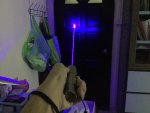


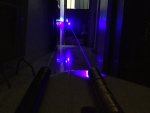
My 532nm SD-laser 303(95mw) VS Challenger II 3W 450nm
Conclusion :
Pros :
Cons :
In conclusion, the Sanwu Challenger II 3W 450nm is a great laser. Despite it's quirks, the overall quality and functionality make up for its minute flaws. I recommend Sanwu lasers and give them a 9/10
FYI, I am not paid or given any additional benefits from Sanwu to make this review
Hello LPF, I decided to get my first Sanwu laser, a Challenger II multi-mode 3W 450nm laser, and would be reviewing it in this post. As I am a new member, my review may not meet some of your criteria so I hope you will not be too critical. Anyway, let's jump into the review
Shipping :
I placed my order on 20/05/2019 for a multi-mode challenger II 3W 445nm with 18650 battery configuration, together with 2 protected 18650 3300mAh Panasonic battery. Within 8 days, I received an email from Francis notifying me that my order has been dispatched. It arrived to my country on 01/06/2019 and finally received it on 06/06/2019. The laser was packed in poly bubble padded envelope/parcel with 2 poly bubble padded bags inside, one for the laser head and the other for the laser body/tube and tailcap. The batteries came separate a few days earlier.
First impression of laser :
The most prominent properties of the laser its is mass. This laser is HEAVY! I own 2 other blue laser, a cheap WickedLasers style 1.3w and a DIY multi-mode laser, one of of which have a similar mass to the Sanwu laser despite being twice in length and volume. The treads are butter smooth and pre lubricated. The CNC engraved patterns are sharp and looks very unique. No burrs or scratches were seen on the laser, further emphasising on the high quality of Sanwu lasers.
Each separatable section of the laser includes a white o-ring, hence leading to me believing this is at least IPX4 water resistant(resist splashing water from all directions). One thing I noticed is that the driver is soft start. When turned on, the laser will start at <10mW output and then ramps up to full power in about a second, thus protecting the diode from voltage & current spikes. Furthermore, it also features a high temperature protection whereby the power output will be reduced if the temperature is too high. I noticed this when my beam brightness would slightly reduce suddenly after running the laser as full power(3W) for about a a minute and a half. This however did not help in the duty cycle conundrum which I will further discuss below.
Another thing that I noticed when I got the laser is that it includes a AR coated lens protector screwed in front of the G7 lens which keeps dust out and prevent the actual G7 lens from getting scratched. None of my other lasers include this feature so I am very impressed with Sanwu willingness to help their customers in terms of laser maintenance.



NDB7875 Diode(9mm)

AR coated G7 lens protector with its own rubber o-ring
Specifications from Sanwu :
Laser body material : Nickel Copper Alloy(Cupronickel)
Size : 140mm X 24mm
Operation mode : Multi-mode
Laser Max Power : 3000mW
Divergence : 0.7mrad - 3.8mrad[Further calculation done below]
Voltage : 3.7V - 4.2V
Current : 0.5A - 2.2A[Further testing done below]
Power Supply : Single 69mm 18650 battery
Modes : Low Power, Half Power, Strobe, Full Power, SOS
Duty cycle : Unlimited except 4W 470nm(60s on & 80s off) --- [Further testing done below]
Laser Diode : NDB7875
NDB7875 diode manufacture specs :
Dominant Wavelength : 435nm - 450nm
Optical output : 1.6W @ 1.2A
Max Current : 1.7A
Operating Voltage : 3.7V - 5.5V
Package Size : 9mm
Build In Static Protection : Yes
Operating Temperature : 0 - 50 degree celcius
Qualitative Data Measurements :
Unfortunately, I do not have a LPM thus my assessment would not contain power readings:sad:
MASS :
Laser mass without battery : 217g
Laser mass with battery : 262.5g
CURRENT:
Sadly, I lost pictures for the tailcap current readings but I have prerecorded the measured tailcap currents on my iPhone notes.
Low power mode : 0.09A
Half power mode : 1.07A
Full power mode : 2.26A
*The current for strobe and SOS fluctuates so no readings are taken for these modes.
DUTY CYCLE :
Sanwu advertised this laser to have unlimited duty cycle. However, I soon found out that this was untrue. In full power mode, the laser reached 53.3 degree celcius in about 1 minute and 48 seconds and about 3 and a half minutes in 1/2 power mode. Hence, this laser HAVE a duty cycle as the NDB7875 diode reaches max operation temperature, 50 degree celcius, after a duration of time. Therefore, my personal duty cycle is 60 seconds on, 90 seconds off.(all temperature tastings are done in room temperature of 25.8 degree)


Measured divergence & Distance for safe laser Power Density :
As Sanwu's advertised divergence is a pretty large range, I decided to do my own test. Distance between the G7 lens optical centre to my wall is 9.065m. Diameter of beam at distance of 0m is 6mm and 17.5mm at 9.065m. Based on an online calculator, this gives a full-angle divergence of 1.27mrad.
Edit :
I was playing with the laser when I realised that the divergence calculated may be wrong since the dot area is larger than expected. Apprently, my intuition was correct.
Diameter when dist = 0m is 6mm
Test 1 :
Dist = 9.136m
Dia = 38mm
Divergence = 3.5mrad
Test 2 :
Dist = 6.001m
Dia = 20mm
Divergence = 2.33mrad
Test 3 :
Dist = 4.496m
Dia = 18mm
Divergence = 2.67mrad
Hence, divergence is from 2.67mrad - 3.5mrad. Way higher than my initial calculation and more in tune with Sanwu's listed specification.
Safety is my no. 1 concern in this hobby. Hence, I decided to do more calculations to find out what distance, in meter, would the laser power density be too Low to hurt the human eye when operated at the full 3W power :
Eye safe Power Density = 25W/m^2 = 25000mW/1000mm^2 = 0.025mW/mm^2 -- α
Assuming the relationship between the length and breath of a rectangular beam of a multi-mode diode increases linearly and proportionally with each other, Let Y be the breath and X be the length.
When Y = 9mm , X = 75mm -- 1
When Y = 13mm , X = 90mm -- 2
When Y = 25mm , X = 138mm -- 3
From 1, 2 & 3 :
Y = kX , where k is an arbitrary constant.
k = Y/X
1 : k = 9/75 = 0.12
2 : k = 13/90 = 0.14444
3 : k = 25/138 = 0.18556
∴ kAvg = (0.12 + 0.14444 + 0.18556)/3 = 0.15000
∴ Formula for calculating Sanwu Challenger II 3W 445nm Laser Area is :
Y = 0.15X
For Power density <= α, Power Density @ 3000mW :
3000mW/(Y x X)mm^ <= 0.025mW/mm^2
3000/0.15X^2 <= 0.025
X^2 <= 800,000
X >= 894.427mm(0.9m)
Hence from an online divergence calculator ,
When X = 895mm(Dia), full-angle divergence is 2.67mrad, power density < 0.25mW/mm^2, distance to object is 700m. Therefore, I Ensure that buildings I am pointing to is more than 700m to Ensure eye safety of others.
EDIT : I did NOT point the laser at any buildings, aircraft or living things. I said that I point my laser at buildings as this is just my way of expressing my math in English and as a proof of concept mathematically:Math:
Issues :
Despite the excellent quality of the laser, there is 4 quirks I would need to address.
Firstly, the length of the metal tube is fairly Long. Thus, as advertised, 18650 batteries must be longer than 69mm in order to make proper contact with the terminal. I needed to use protected 18650 Li-lon batteries as my unprotected ones are too short.
Secondly, the laser is made of nickel copper alloy(Cupronickel) which conducts heat away from the diode quickly but is fairly soft. Hence, the laser can be easily scratched when not careful. I made a mistake by putting my keys and laser in the same bag which resulted in some shallow scratch marks. Fortunately, I was able to remove majority of the marks with a jewellery metal polishing cloth.
Thirdly, as mention above, the laser is falsely advertised to have no duty cycle. The manufacturer stated specifically that the max diode operating temperature is 50 degree celcius but my measurement with an IR thermometer shows that the host temperature can be as high as 53 degree celcius. Constantly running the laser diode past it's max operating temperature will shorten its lifespan and lead to premature failure of the diode.
Fourthly, the half clicks for the multi-mode versions of Sanwu lasers is a it finicky. If you press too fast or too slow, the laser microcontroller will not be able to register the clicks. The secret formula which I found was to wait for 1 second after the laser is turned on and lightly tap the button @ interval of 0.25 second per 1/2 click. Don't push too hard of the laser may register it as more than one 1/2 click due to the bounce effect of buttons.
On the subject of 1/2 clicks, I noticed that my laser multi-mode operation is different than advertised. According to Sanwu, after unlocking the laser with five 1/2 clicks, the user can navigate through the 5 modes using 1/2 clicks to transit to the next mode. This was not the case for me. It seems that the driver in the laser is designed for the original Challenger series as the modes you enter depends on the no. of 1/2 clicks the user do within 3 seconds and not doing 1/2 clicks to transit to the next mode. As quoted from the Sanwu for the original Challenger series multi-mode laser : '
Laser Function
How to Power the Laser On
Press the power button.
Multi-Operation Mode
Perform these sequences within the first three seconds of powering on the laser to enter the different operational modes:
Three half presses: Low power mode
Four half presses: Half power mode
Five half presses: Strobe mode
Six half presses: Full power mode
Seven half presses: SOS mode
The laser memorizes the operational mode last used for more than five seconds. This feature allows you to start the laser into the last operating mode without entering the button sequence pattern. '(end of quote)
Since the multi-mode operation on my Challenger II laser was different from the one Sanwu advertised, I was a little upset as I kept thinking was laser was in lock out mode and thus repeatly did five 1/2 presses like a retard. If anyone who bought a Challenger II multi-mode experience similar problem regarding 1/2 click clicks, I hope this may help you.
Beam Shots :
Enough of all the math and grandmotherly talks. Let's get to the juicy beamshots




My 532nm SD-laser 303(95mw) VS Challenger II 3W 450nm
Conclusion :
Pros :
- Small and portable
- Very nice weight(262.5g with battery)
- High quality machining of metal
- Laser body is made of Cupronickel which keeps diode cooler than other material( Low specific heat capacity)
- Soft Start diode protection
- High temperature protection
- Reverse polarity, over-charge & over-discharge protection
- Water resistant(at least IPX 4)
- AR coated G7 lens protector
- Multi-mode driver
- Low power mode(<10mW), can be use a a pointing device without worrying about blinding someone
Cons :
- Only 18650 batteries 69mm and above in height can be used, hence unprotected batteries cannot be used
- Nickel copper alloy(Cupronickel) is soft can can be easily scratched when not careful
- Laser have a duty cycle despite being advertised by Sanwu that its duty cycle is unlimited.
- Half clicks can be finicky and take some time to get used to
- Laser seems to have the wrong driver(see above in the section issues, part 4)
In conclusion, the Sanwu Challenger II 3W 450nm is a great laser. Despite it's quirks, the overall quality and functionality make up for its minute flaws. I recommend Sanwu lasers and give them a 9/10
FYI, I am not paid or given any additional benefits from Sanwu to make this review
Last edited:




